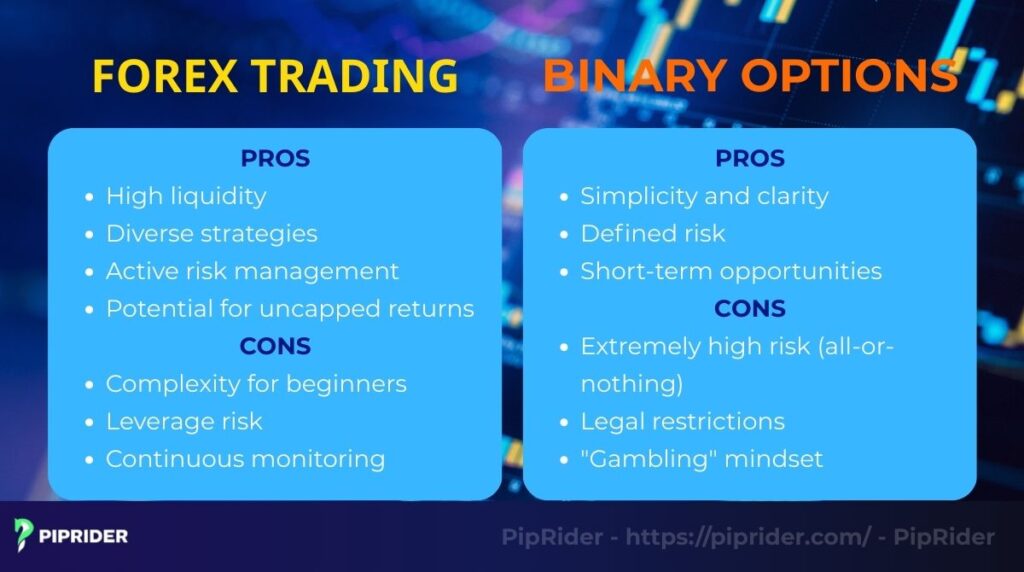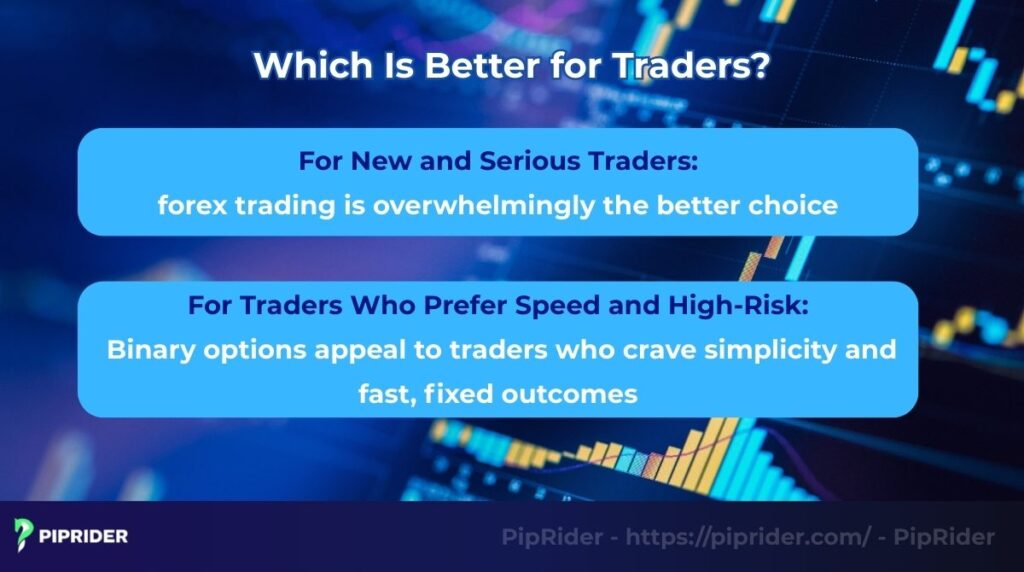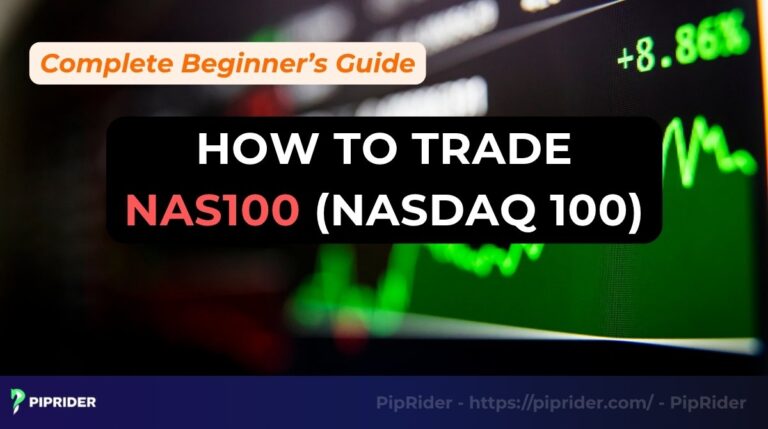A frequent source of confusion for new traders concerns the fundamental distinction between Forex trading and Binary Options. While both methods involve speculating on price movements in financial markets, they differ significantly in their mechanics, risk profiles, profit potential, and legal frameworks.
This comprehensive guide will break down these critical differences, providing clarity on the distinct nature of each financial instrument to answer the question: What Is the Difference Between Forex and Binary Options?
Key Takeaways
- Forex Trading: You buy or sell currency pairs, and your risk and reward depends on how much the price moves in your favor.
- Binary Options: You place an “all-or-nothing” bet on whether an asset’s price will be above or below a certain point at a fixed expiry time, with a fixed return.
- Forex offers flexible risk and reward that you can manage, while binary options present a higher-risk, fixed outcome.
- The forex market is widely regulated globally, whereas binary options are heavily restricted or banned in many countries due to their high-risk nature.
- The right instrument for you depends on your trading goals, personal style, and, most importantly, your tolerance for risk.
1. What Is Forex Trading?
Forex trading is the act of buying and selling currencies on the foreign exchange market, with the aim of profiting from fluctuations in their exchange rates. This is the largest and most liquid financial market in the world.

Unlike trading a single stock, Forex trading always involves trading currency pairs (such as EUR/USD or GBP/USD). Placing a trade means an investor is simultaneously buying one currency while selling the other, based on the speculation of which currency will appreciate in value relative to the other.
The process involves several key concepts:
- Pip & Lot Size: Trades are measured in pips (the smallest unit of price movement) and executed in standardized quantities called lot sizes.
- Spread: The spread is the small cost of a trade, representing the difference between the buy and sell price.
- Leverage: Brokers offer a tool that allows you to control a large position with a small amount of capital (margin).
Main advantages of forex trading include:
- High Liquidity: With trillions of dollars traded daily, it’s generally easy to enter and exit trades, even during high market volatility.
- 24/5 Market Access: The market operates around the clock five days a week, offering flexibility with its extensive trading hours.
2. What Are Binary Options?
Binary options are a type of exotic financial option where the payoff is either a fixed monetary amount or nothing at all. Think of it as a simple “yes or no” proposition that can be applied to various markets, including commodities and futures.

The trader speculates on whether the price of an asset (like a stock, currency, or futures contract) will be above or below a certain price at a specific point in time (the “maturity time”). This timeframe can be extremely short, sometimes as little as 30 seconds or one minute.
The outcome is a fixed, “all-or-nothing” payout:
- If the prediction is correct, traders receive a predetermined fixed return, typically 70-90% of the investment.
- If it is wrong, traders lose your entire initial investment.
This high-risk, all-or-nothing structure has led to binary options being highly controversial. Many financial regulators around the world, including in the UK and the European Union, have banned or severely restricted their sale to retail traders, citing concerns about investor protection and their similarity to gambling (FCA, 2019)..
3. What is the Difference Between Forex and Binary Options?
While both involve financial markets, the way to trade, the risk to take, and the potential outcomes are fundamentally different.
Here is a summary table of the key distinctions:
| Feature | Forex Trading | Binary Options |
| Mechanism | Buy/sell trading pairs; reward scales with the size of the price move. | Predict if the price will be up or down at a fixed time. |
| Risk/Reward | Flexible; you can close trades anytime to lock in reward or cut drawdowns. | All-or-nothing; a fixed payout if correct, total drawdown if wrong. |
| Trade Duration | No time limit; you have full control over when to close a position. | Fixed expiry time (e.g., 30s, 1m, 5m). |
| Regulation | Widely regulated in most countries by top-tier authorities. | Heavily restricted or banned in many countries. |
| Popularity | The largest and most established global financial market. | A smaller, less common niche often viewed as high-risk. |
3.1. Mechanism of Trading
In forex trading, risk and reward is directly proportional to how much the price moves. A 100-pip move in trader’s favor will be ten times more profitable than a 10-pip move, requiring a clear strategy.
In contrast, binary options are a simple “yes/no” bet. The amount the price moves doesn’t matter; traders only care if it closes above or below their entry point at the exact moment of expiry.
3.2. Risk & Reward Profile
Forex offers a flexible risk and reward profile. Traders are in control, able to use a stop-loss to define maximum risk and close a trade at any point to take a small or large reward. The risk/reward ratio in binary options is fixed and rigid. It’s an “all-or-nothing” outcome where traders know the exact potential gain or drawdown before entering, but they have no control once the trade is placed.
3.3. Trade Duration
Forex trades have no predetermined time limit. A position can be held for seconds, hours, days, or even months, depending on strategy. Every binary option has a fixed maturity time, which can be extremely short (e.g., 30 seconds or 1 minute). This means the speculation must be correct within that exact, and often very brief, timeframe.
3.4. Regulation and Reputation
Forex trading is a core part of the global financial system and is regulated by top-tier authorities in most major countries, with licensed brokers offering services to the public. Due to their high-risk, gambling-like nature, binary options have faced intense regulatory scrutiny and are banned for retail investors in many jurisdictions, including the UK and the European Union (ESMA, 2018).
3.5. Popularity and Market Standing
The forex market is the largest and most liquid financial market in the world, essential for global commerce. Binary options occupy a much smaller, more controversial niche in the trading world and are often associated with high-risk, speculative betting rather than traditional market trading.
4. Pros and Cons of Forex vs Binary Options
After knowing what is the difference between forex and binary options, to further clarify the choice between these two instruments, let’s look at their respective advantages and disadvantages.

4.1. Forex Trading
When considering forex trading, it’s important to weigh its benefits against its potential drawbacks, especially for those new to the market.
Pros
- High liquidity: The sheer size of the forex ensures high liquidity, making it easy to enter and exit trades at competitive prices.
- Diverse strategies: It supports a vast array of trading strategies, from long-term position trading and medium-term swing trading to short-term scalping, allowing traders to adapt.
- Active risk management: Traders have full control over their risk. They can set stop-loss orders to limit potential drawdowns and take-profit orders to lock in gains.
- Potential for uncapped returns: Unlike fixed payouts, the potential return in a successful trade is theoretically unlimited.
Cons
- Complexity for beginners: Understanding concepts like pips, lots, leverage, and economic indicators can be complex.
- Leverage risk: While a benefit, leverage is a double-edged sword that can significantly magnify losses.
- Continuous monitoring: Some strategies require consistent monitoring, which can be demanding.
4.2. Binary Options
Despite their initial appeal of simplicity, binary options come with a unique set of pros and, more significantly, cons that beginners must understand.
Pros
- Simplicity and clarity: The “yes/no” nature makes binary options easy to understand. Traders know the maximum risk and potential reward upfront.
- Defined risk: The “all-or-nothing” fixed return means traders know exactly how much they stand to lose before entering the trade.
- Short-term opportunities: It offers opportunities for very short-term speculation.
Cons
- Extremely high risk (all-or-nothing): A single wrong prediction means a total drawdown of the investment for that trade.
- Limited profit potential: Payouts are typically capped at 70-90% of the stake, making it harder to recover losses.
- Legal restrictions: Binary are banned or heavily restricted for retail investors in many major jurisdictions.
- “Gambling” mindset: The fixed-payout nature can foster a gambling mindset, encouraging impulsive decisions rather than proper technical analysis.
5. Which Is Better for Traders?
The “better” instrument truly depends on what you are trying to achieve. Are you looking to build a sustainable trading skill, or are you seeking a high-risk, short-term bet? The answer to that question will guide your choice.

5.1. For New and Serious Traders
For investors looking to build a long-term skill, forex trading is overwhelmingly the better choice. It operates in a more transparent and regulated environment and allows for the development of real trading skills: analysis, flexible risk control, and the ability to cut losses or let rewards run.
5.2. For Traders Who Prefer Speed and High-Risk
Binary options appeal to traders who crave simplicity and fast, fixed outcomes. However, this ease of use comes at the cost of extremely high risk and a statistical edge that is often stacked against the speculator.
6. Frequently Asked Questions (FAQs)
7. Summary: Making Your Informed Choice
What is the difference between forex and binary options? The key differences lie in mechanism, risk, and legal framework.
Forex trading offers a flexible, skill-based path with active risk management in a regulated global market. In contrast, binary options are a simpler, “all-or-nothing” proposition with extremely high risk and significant regulatory restrictions in many countries.
For most traders seeking a sustainable career, forex trading is the more robust and recommended choice. Your final decision should always be based on your personal risk tolerance.
To continue building your knowledge, we encourage you to explore our comprehensive guides in the Trading Strategies category on Piprider.








